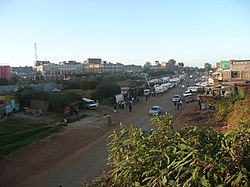Kikuyu, Kenya
Kikuyu | |
|---|---|
 Kikuyu in 2009 | |
| Country | |
| County | Kiambu County |
| Population (2009) | |
| • Total | 233,231 [1] |
| Time zone | UTC+3 (EAT) |
Kikuyu is a town in the Kiambu County of Kenya. The town is located 20 km (12 mi) northwest of central Nairobi, the capital of Kenya. Kikuyu hosts a town council and an administrative division in Kiambu County. It is about 20 minutes from Nairobi via a number of routes, including a dual carriage road, and it has a railway station on the Uganda Railway. Transport to the capital and other places is available in form of matatus, minibuses and trains. Many institutions have developed in this town, including a major eye unit hospital, a Christian university, and many primary and secondary schools. Recreational facilities and accommodations include Sigona Golf Club, the Wida Highway Motel, Kari Holiday Retreat Center, and the PCEA Lay Training Center. It has developed into an industrial town that boasts many factories that range from the metallic to the medical sector.
The town is named after Kĩkũyũ people, the major ethnicity that has settled in the area. As of 2009 the total population is 233,231.[2] Due to its geology and rich soil texture, there is much livestock and crop farming. In 2009 the population had grown to 190,208 people.[3]
The town has some British colonial history links like the Right Reverend MusaGitau (Swahili for Moses Gitau), an African believer in democracy who led among the first Christian faithful during colonial times. He lived and worked in the town as a reverend and in his honor two schools were named after him.
An interdenominational missionary conference held in Kikuyu in June 1913 provoked the so-called Kikuyu controversy, which briefly roiled the Anglican churches from December 1913 to February 1914.
Schools
- Kenya Forestry Research Institute, Kenya Agricultural Research Institute, Alliance High School, Alliance Girls High School, The Green Garden Schools, Jeverden Highlands Academy, St. Veronica I.L.C, Thogoto Teachers' College, Musa Gitau Primary School, and Mary Leakey Girls Secondary School at the fringes of the Nairobi city boundary, which was started by the famous Leakey family of archeologists.
Historical Sites
- There are several historical sites within the town, such as the underground caves dug by Indian coollies when constructing the Kenya-Uganda railway. These caves are found just below the town under the railway facing Magana farm. Other sites include the graves of two explorers who were killed by lions in the 19th century at Kanyariri, a few meters from where Fort Smith was situated; the Undiri swamp a stone's throw from the town's CBD; the Anglican Mothers Church at Kabete; and the PCEA Church of the torch, the first building at Thogoto.
See also
- Kabete, a town in the Kikuyu division
References
- ^ http://kenya.usaid.gov/sites/default/files/profiles/Kiambu_Dec2011%2029.pdf
- ^ http://kenya.usaid.gov/sites/default/files/profiles/Kiambu_Dec2011%2029.pdf
- ^ Kenya: Provinces, Major Cities, Municipalities, Towns & Urban Centres - Statistics & Maps on City Population. Citypopulation.de. Retrieved 22 June 2012.
